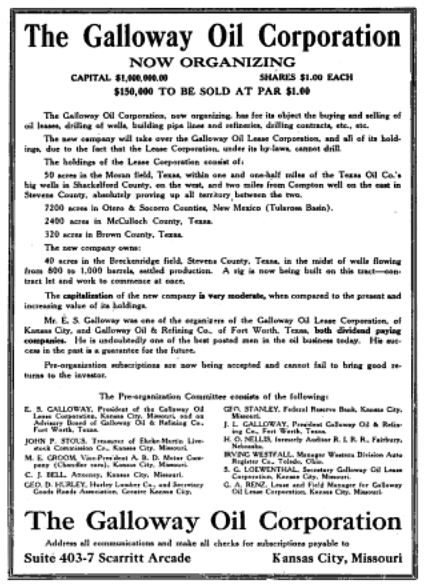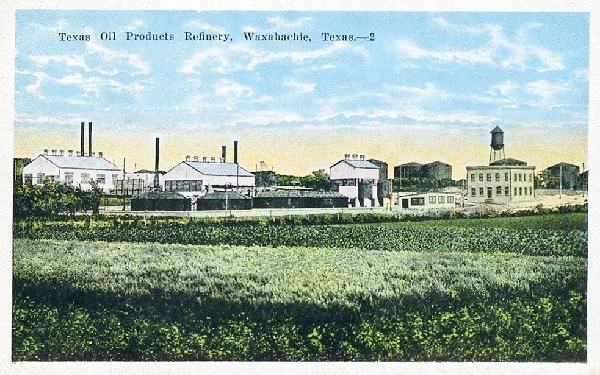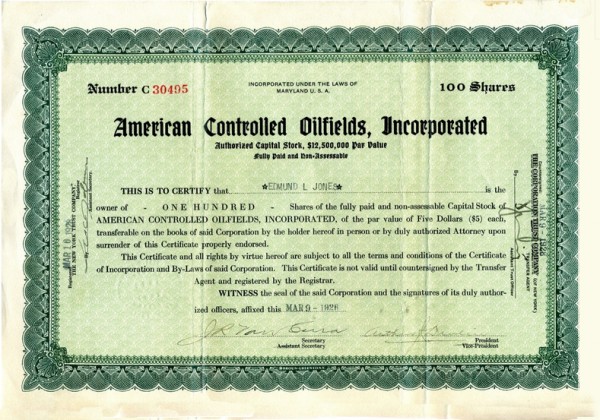by Bruce Wells | Aug 24, 2013 | Petroleum Companies

Galloway Oil Corporation came to life as a combination of companies. The Galloway Oil Lease Corporation of Kansas City, Missouri, and the Galloway Oil & Refining of Fort Worth, Texas, combined in 1923 to form Galloway Oil with $10 million in capital stock.
Just two years earlier, Missouri officials had revoked Galloway Oil & Refining’s charter for failure to pay taxes.
A skeptical article in United States Investor described the highly promoted combination as “attempting to reload stockholders in the defunct concern” by the “Galloway oil interests of Fort Worth.”
Galloway advertised the combination as a way to exploit properties held by Galloway Oil Lease Corporation in the Burkburnett and Desdemona oilfields in Texas.
Learn more about North Texas oil discoveries in Boom Town Burkburnett.
The “Galloway interests” were very active in the merging of petroleum businesses.
They had previously merged Texas-Penn Oil Company with the Galloway Oil & Refining under the name of Galloway Consolidated Company – as well as forming the North Iowa Oil & Refining Company of Lawton, Oklahoma, in 1917.
Today, Galloway Oil Lease Corporation and the other Galloway enterprises stock certificates can be found on eBay. They only have collectible value.
___________________________________________________________________________________
The stories of exploration and production companies joining petroleum booms (and avoiding busts) can be found updated in Is my Old Oil Stock worth Anything? The American Oil & Gas Historical Society preserves U.S. petroleum history. Please support this AOGHS.ORG energy education website. For membership information, contact bawells@aoghs.org. © 2018 Bruce A. Wells.
by Bruce Wells | Aug 21, 2013 | Petroleum Companies
Texas Oil Products Company incorporated in 1918 with $850,000 capitalization specifically to build a $750,000 refinery near the Houston & Texas Central Railroad south of Dallas, just outside of Waxahachie’s western city limits.
 Founded in 1850, Waxahachie has been an agricultural, commercial, and transportation center in North Texas. Ellis County was one of the nation’s largest cotton-producing counties during the early 1900s.
Founded in 1850, Waxahachie has been an agricultural, commercial, and transportation center in North Texas. Ellis County was one of the nation’s largest cotton-producing counties during the early 1900s.
With U.S. demand for gasoline soaring, the Texas Oil Products sought new technologies for its new refinery, planning for a capacity to process 3,000 barrels of oil a day.
The company turned to the Bostaph Engineering Corporation, which had recently patented a “ramage vapor-phase cracking process” (patent no. 1,224,787) to increase the amount of gasoline that could be extracted from each barrel of oil.
Construction began in 1920 and the Waxahachie refinery was up to 1,000 barrel a day capacity by 1922. The company marketed its high-grade gasoline as “Topoline.”
Although incorporated in Arizona, the Texas Oil Products executive offices were in Detroit. The president was G. Carl Fisher and vice president was Robert J. Fisher.
In December 1922, United States Investor reported the company, now capitalized at $3 million, had run afoul of the Michigan Securities Commission and was suspended from selling its stock.
“Many reputable brokers of Detroit are not handling the stock,” the publication noted. Some reports said the company floundered due to legal difficulties and pollution.
By court order, Texas Oil Products Company’s idled refinery was sold in 1930 to Star Oil & Refining Company of Fort Worth.
Today the Waxahachie Country Club sits on the old refinery property.
___________________________________________________________________________________
The stories of exploration and production companies joining petroleum booms (and avoiding busts) can be found updated in Is my Old Oil Stock worth Anything? The American Oil & Gas Historical Society preserves U.S. petroleum history. Please support this AOGHS.ORG energy education website. For membership information, contact bawells@aoghs.org. © 2018 Bruce A. Wells.
by Bruce Wells | Aug 2, 2013 | Petroleum Companies
Sharing history about the U.S. petroleum exploration and production industry.
You found an old petroleum stock certificate in your attic and hope you might be a millionaire. Unlikely, but here is a free discussion forum about old oil companies. Be sure to check the more than 100 old oil companies already researched in Is my Old Oil Stock worth Anything?
Welcome to the American Oil & Gas Historical Society’s discussion page for often obscure petroleum stock certificates. Although the U.S. oil and natural gas industry, launched by an 1859 oil discovery in Titusville, Pennsylvania, has drilled millions of wells, chances are the certificate you found will not make you rich.
Unless it is valued by collectors, outdated financial certificates today have little value — except as family keepsakes. (more…)
by Bruce Wells | Jul 27, 2013 | Petroleum Companies
American Controlled Oilfields was incorporated in Maryland January 10, 1925, ”to contract for lands, maintain claims, oil wells, gas wells, oil lands and other real property.” It joined many other oil exploration companies seeking investors to fund drilling.
Incorporated by Camille Weidenfeld, Robert O. Deyer and Enos Curtain with offices in the Calvert Building in Baltimore, the company was capitalized at $12.5 million and assigned a stock par value as $5.

Stock certificate for American Controlled Oilfields Inc. Like many small oil exploration companies, stockholders and investors were ask to fund drilling near proven oilfields.
American Controlled Oilfields, Inc., eventually owned acreage in Louisiana (De Soto and Sabine parishes) and Kansas (Anderson County). (more…)
by Bruce Wells | Jul 24, 2013 | Petroleum Companies

Probably formed during the North Texas oil booms of the 1920s, Horseshoe-Western Oil Company of Wichita Falls, Texas, did not leave much of a footprint after the Great Depression.
The company began with leases on 30 acres in Tillman County, Oklahoma, just across the Red River Texas border of the booming oil town of Wichita Falls.
The new company guaranteed to drill at least one well to a maximum depth of 2,000 – promising to pay 75 percent of earnings in monthly dividends to investors if the well was successful.
The company’s “Get in Today” advertisement in the Corpus Christi newspaper proclaimed riches to be had by acting quickly.
“We want you to look over all the companies and see if any offer you the square deal we do,” the company added, noting its leadership would remain in Wichita Falls. It claimed to have leases on a famous producing region.“We warn you right now – that if you have any idea of thinking this over for a week or so, you had just as well forget it now, because we expect of be sold out and drilling by that time,” the Wichita Falls oil company declared.
The Burkburnett oilfield, discovered on July 29, 1918, on S.L. Fowler’s farm, had brought thousands of people to North Texas. Twenty trains ran between Burkburnett and Wichita Falls every day.
With only $130,000 in capitalization, it does not appear Horseshoe-Western Oil Company survived. Learn more about North Texas petroleum history in Pump Jack Capital of Texas.
Please support the American Oil & Gas Historical Society with a donation.


 Founded in 1850, Waxahachie has been an agricultural, commercial, and transportation center in North Texas. Ellis County was one of the nation’s largest cotton-producing counties during the early 1900s.
Founded in 1850, Waxahachie has been an agricultural, commercial, and transportation center in North Texas. Ellis County was one of the nation’s largest cotton-producing counties during the early 1900s.

